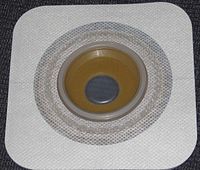- Ostomy pouching system
-
An ostomy pouching system (also colloquially called a bag) is a medical device prosthetic that provides a means for the collection of waste from a surgically diverted biological system (colon, ileum, urinary) and the creation of a stoma. Pouching systems are most commonly associated with colostomies, ileostomies, and urostomies.[1]
Pouching systems usually consist of a collection pouch bag,[2] known as a one-piece system or, in some instances involves a mounting plate, commonly called a wafer or a baseplate, and a collection pouch that is attached mechanically or with an adhesive in an airtight seal, known as a two-piece system. The selection of systems varies greatly between individuals and is often based on personal preference and lifestyle. Ostomy pouching systems collect waste that is output from a stoma. The pouching system allows the stoma to drain into a sealed collection pouch, while protecting the surrounding skin from contamination.[3]
Ostomy pouching systems are air- and water-tight and allow the wearer to lead an active normal lifestyle that can include all forms of sports and recreation.
Ostomy pouching systems are also sometimes referred to as an appliance, where the term appliance refers to a prosthesis, as a mechanical replacement for a biological function.
Contents
Wafers/Baseplates
Most wafers/baseplates are manufactured using pectin or similar organic material and are available in a wide variety of sizes to accommodate a person's particular anatomy.The internal opening must be the correct size to accommodate the individual's stoma while protecting the skin from contact with waste. The methods for sizing this opening vary depending on the type of wafer/baseplate; some pre-cut sizes are available, however most users normally customize the opening using scissors. Manufacturers have recently introduced moldable wafers than can be shaped by hand without the need for scissors.[1]
Skin adhesion for modern wafers/baseplates are optimized on all the five parameters required in an adhesive:
- absorption
- tack and adhesion
- flexibility
- erosion resistance
- ease of removal.
A wafer/baseplate may last between four to ten days before it needs to be replaced; this is highly dependent on the individual's lifestyle, ostomy type, and anatomy.
Pouches
 A typical ostomy pouch, in this case a closed-end or "disposable". Note the flange ring, which uses a "Tupperware" type of seal.
A typical ostomy pouch, in this case a closed-end or "disposable". Note the flange ring, which uses a "Tupperware" type of seal.
For maximum hygiene and to reduce risk of infection, a one-piece (open-end) bag should be changed every twenty-four hours. A two-piece bag's base plate should be changed weekly with the bag changed every twenty-four hours.
The method of attachment to the wafer varies between manufactures and includes permanent (one-piece), press-on/click ("Tupperware" type), turning locking rings and the recently introduced "sticky" adhesive mounts. The two-piece arrangement allows pouches to be exchanged without removing the wafer; for example, some people prefer to temporarily switch to a "mini-pouch" for swimming, intimate and other short-term activities. Mini-pouches are suitable for minimum usage only.
Pouches can be broken down into two basic types: open-end (drainable) and closed-end (disposable).
- Open-end pouches have a resealable end that can be opened to drain the contents of the pouch into a toilet. The end is sealed Velcro-type closure at the end that eliminates the need for a clip.
- Closed-end pouches must be removed and replaced with a new pouch once the bag is full. This system can cause extreme damage to the skin area under the adhesive due to the frequency of removal and re-application.
The use of open-end vs. closed-end pouches is dependent on the frequency in which an individual needs to empty the contents, as well as economics.[3]
Gas is created during digestion, and an airtight pouch will collect this and inflate. To prevent this some pouches are available with special charcoal filtered vents that will allow the gas to escape, and prevent ballooning at night.
See also
References
- ^ a b "Ostomy Information". United Ostomy Associations of America. http://www.ostomy.org/ostomy_info/whatis.shtml. Retrieved September 3, 2010.
- ^ http://www.mayoclinic.com/health/ostomy/SA00072
- ^ a b Lueder, Wendy. "Ostomates' Choices". Broward Ostomy Association. Archived from the original on 2008-11-21. http://replay.waybackmachine.org/20081121081858/http://www.browardostomy.org/newsletter-articles/ostomate-choices.html. Retrieved September 3, 2010.
External links
Categories:- Surgery
- Gastroenterology
- Surgical procedures
- Medical equipment
- Prosthetics
- Incontinence
Wikimedia Foundation. 2010.


